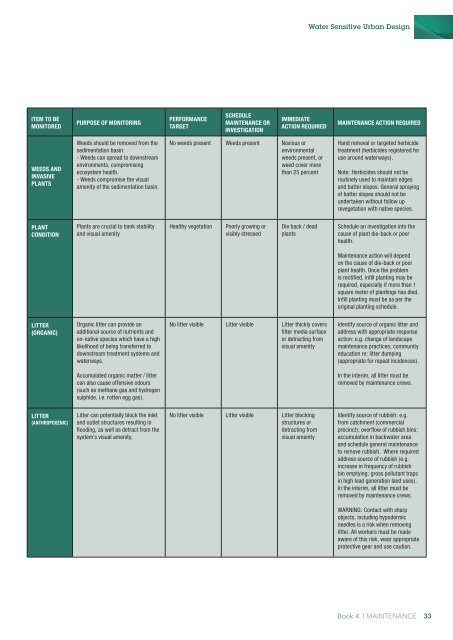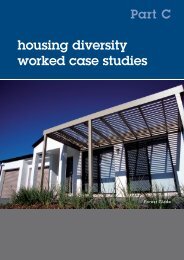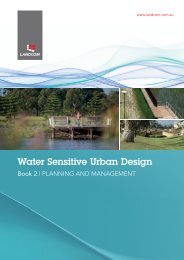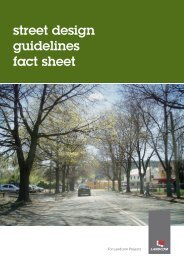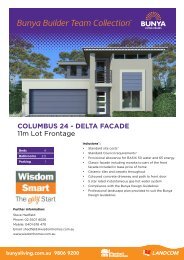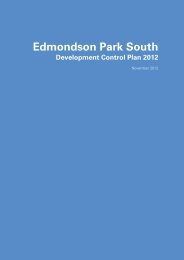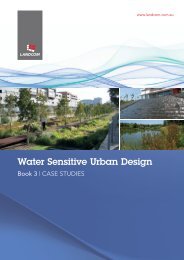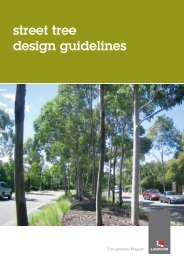Landcom Book 4 Maintenance - WSUD
Landcom Book 4 Maintenance - WSUD
Landcom Book 4 Maintenance - WSUD
You also want an ePaper? Increase the reach of your titles
YUMPU automatically turns print PDFs into web optimized ePapers that Google loves.
Water Sensitive Urban Design<br />
Item to be<br />
Monitored<br />
Purpose of Monitoring<br />
Performance<br />
Target<br />
Schedule<br />
<strong>Maintenance</strong> or<br />
Investigation<br />
Immediate<br />
Action Required<br />
<strong>Maintenance</strong> Action Required<br />
Weeds and<br />
invasive<br />
plants<br />
Weeds should be removed from the<br />
sedimentation basin:<br />
- Weeds can spread to downstream<br />
environments, compromising<br />
ecosystem health.<br />
- Weeds compromise the visual<br />
amenity of the sedimentation basin.<br />
No weeds present Weeds present Noxious or<br />
environmental<br />
weeds present, or<br />
weed cover more<br />
than 25 percent<br />
Hand removal or targeted herbicide<br />
treatment (herbicides registered for<br />
use around waterways).<br />
Note: Herbicides should not be<br />
routinely used to maintain edges<br />
and batter slopes. General spraying<br />
of batter slopes should not be<br />
undertaken without follow up<br />
revegetation with native species.<br />
Plant<br />
Condition<br />
Plants are crucial to bank stability<br />
and visual amenity<br />
Healthy vegetation<br />
Poorly growing or<br />
visibly stressed<br />
Die back / dead<br />
plants<br />
Schedule an investigation into the<br />
cause of plant die-back or poor<br />
health.<br />
<strong>Maintenance</strong> action will depend<br />
on the cause of die-back or poor<br />
plant health. Once the problem<br />
is rectified, infill planting may be<br />
required, especially if more than 1<br />
square meter of plantings has died.<br />
Infill planting must be as per the<br />
original planting schedule.<br />
Litter<br />
(organic)<br />
Organic litter can provide an<br />
additional source of nutrients and<br />
on-native species which have a high<br />
likelihood of being transferred to<br />
downstream treatment systems and<br />
waterways.<br />
No litter visible Litter visible Litter thickly covers<br />
filter media surface<br />
or detracting from<br />
visual amenity<br />
Identify source of organic litter and<br />
address with appropriate response<br />
action: e.g. change of landscape<br />
maintenance practices; community<br />
education re: litter dumping<br />
(appropriate for repeat incidences).<br />
Accumulated organic matter / litter<br />
can also cause offensive odours<br />
(such as methane gas and hydrogen<br />
sulphide, i.e. rotten egg gas).<br />
In the interim, all litter must be<br />
removed by maintenance crews.<br />
Litter<br />
(anthropogenic)<br />
Litter can potentially block the inlet<br />
and outlet structures resulting in<br />
flooding, as well as detract from the<br />
system’s visual amenity.<br />
No litter visible Litter visible Litter blocking<br />
structures or<br />
detracting from<br />
visual amenity<br />
Identify source of rubbish: e.g.<br />
from catchment (commercial<br />
precinct); overflow of rubbish bins;<br />
accumulation in backwater area<br />
and schedule general maintenance<br />
to remove rubbish. Where required<br />
address source of rubbish (e.g.<br />
increase in frequency of rubbish<br />
bin emptying; gross pollutant traps<br />
in high load generation land uses).<br />
In the interim, all litter must be<br />
removed by maintenance crews.<br />
WARNING: Contact with sharp<br />
objects, including hypodermic<br />
needles is a risk when removing<br />
litter. All workers must be made<br />
aware of this risk, wear appropriate<br />
protective gear and use caution.<br />
<strong>Book</strong> 4 | MAINTENANCE 33


